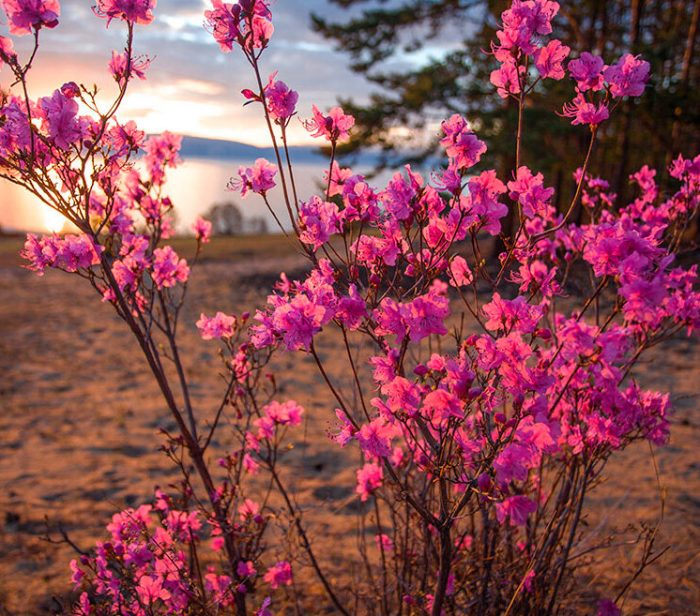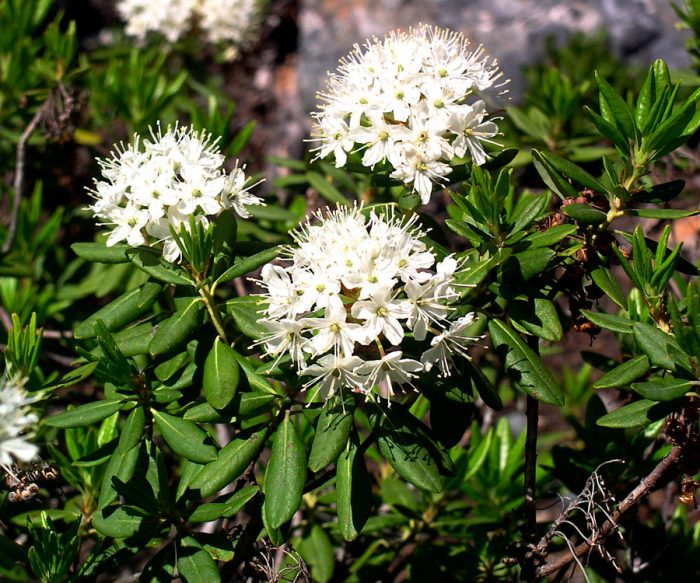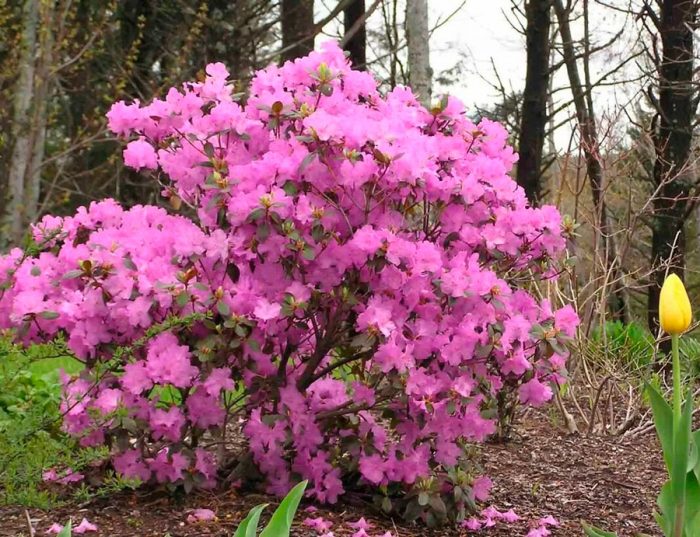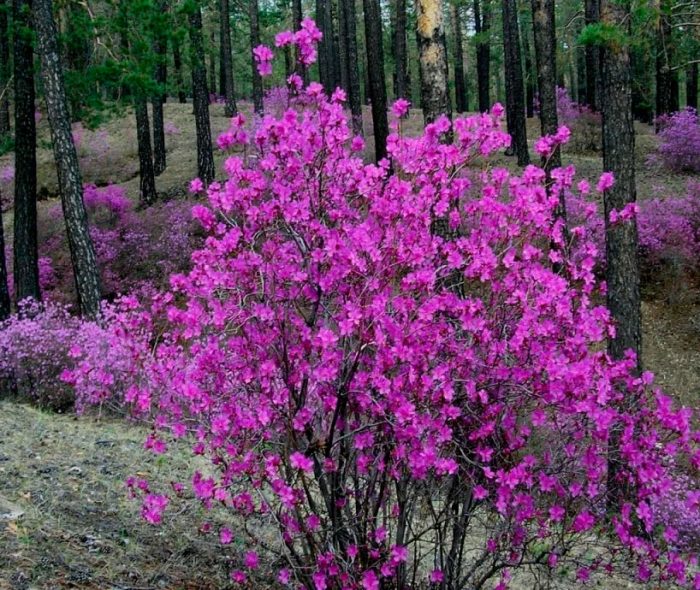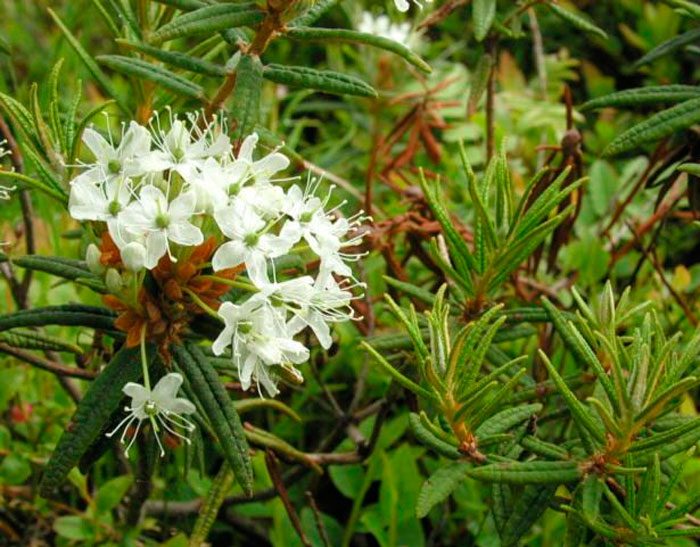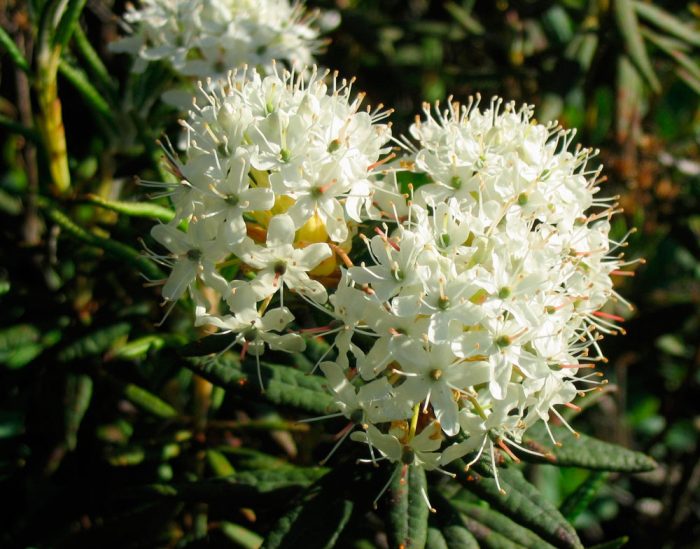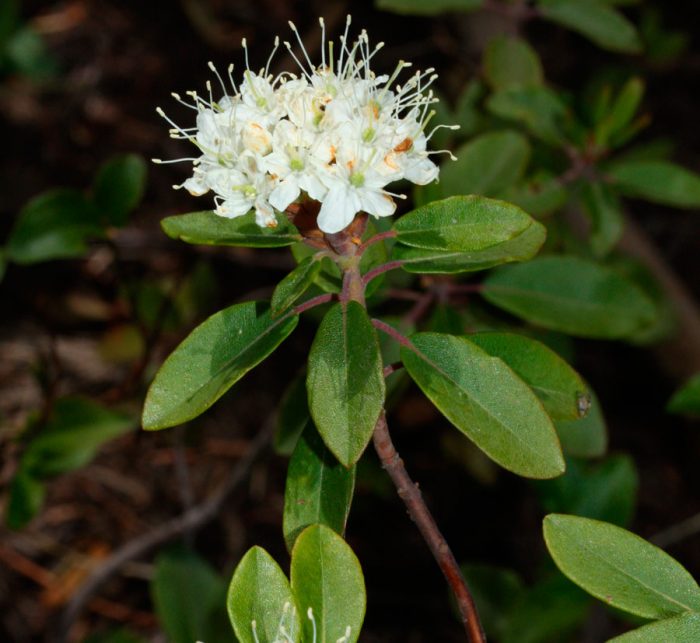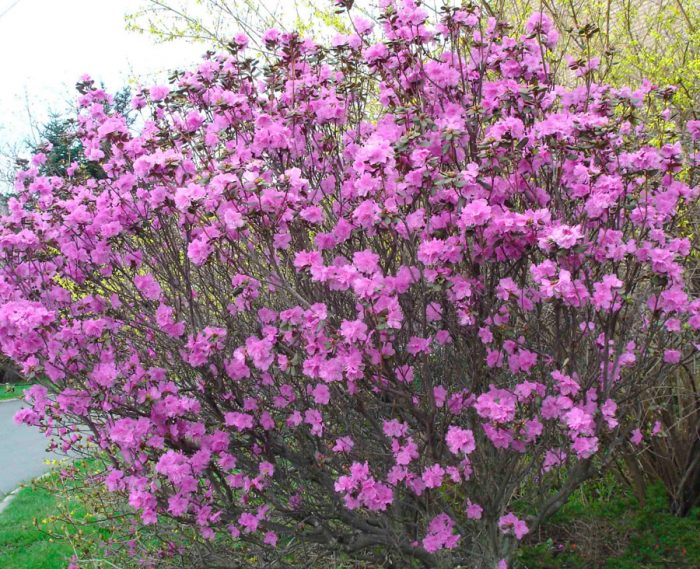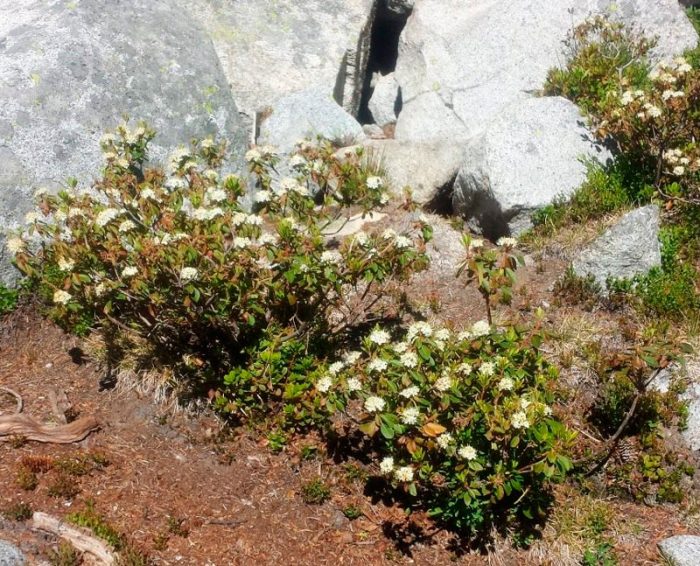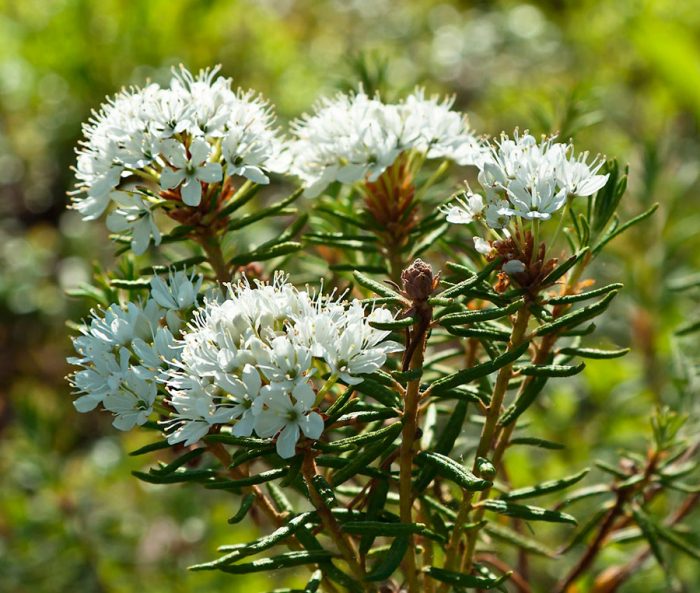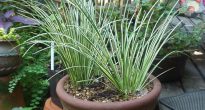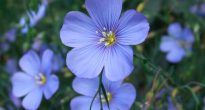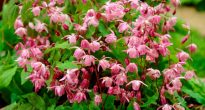Ledum is an evergreen shrub that is part of the Heather family. Scientifically, this plant is called ledum, which makes it closer to incense. Its dense leaf plates, like incense, have a pungent woody odor. Translated from the Old Russian language "wild rosemary" is a poisonous, intoxicating, intoxicating. People also call this plant hemlock, goddess, oregano, wild rosemary.
Wild rosemary is widespread in nature. It can be found in the Northern Hemisphere, or rather, in the temperate subarctic belt. Most often, wild rosemary is grown as a medicinal plant, but some gardeners decorate their garden plots with it.
Content
Peculiarities of wild rosemary
Ledum is a shrub or shrub that is a perennial. Its height varies from 0.5 to 1.2 m. Its rhizome is superficial and branched, and short processes extend from it. Thin branching shoots are quite strong and tough. Depending on the type, the stems are ascending, erect, and also creeping. While the shoots are young, they are painted in a greenish-olive shade, and on their surface there is a rusty pubescence. After some time, a smooth dark bark appears on their surface.
Leafy plates with short petioles do not fly around throughout the year. They are alternately leathery to the touch and painted in a dark green hue. Their shape is lanceolate or elongated, the edge is bent downwards, and a relief median vein stands out on the surface. If the bush is under direct sunlight for a long time, then its foliage acquires a brownish-brown tint. If you rub the leaf between your fingers, you can feel a heady strong aroma.
Dense umbrellas are formed on last year's stems, while flowering lasts from April to June. Each flower has a short stalk. The bell-shaped calyx is formed of white oval petals. Each flower has a multiple of five elements.Pollination of flowers occurs at the expense of insects, then the formation and maturation of dry seed bolls is observed, which have five sections. Each of them contains winged seeds of a very small size.
Pay special attention to the fact that there is poison in any of the parts of this plant! Remember to wash your hands thoroughly after any work with rosemary. But harm from a shrub can be obtained without even touching it, but simply by standing nearby and breathing in its smell. This can lead to feeling weak and dizzy. Despite the fact that this plant can be classified as a melliferous plant, you should know that both pollen and honey also contain poison. You can taste this honey only after prolonged heat treatment and only quite a bit.
Growing in the garden
Landing
Ledum is distinguished by its unpretentiousness and undemanding care. It is recommended to plant a seedling in the garden in the spring. However, if he has a closed root system, then planting can be carried out from spring to autumn.
This plant has a superficial root system. In this regard, the depth of the pit for planting should not exceed 0.4–0.6 m. Do not forget to make a drainage layer with a thickness of 50 to 80 mm at the bottom, for this you should use pebbles or sand. In this case, the site should be picked up with loose and acidic soil. For growing wild rosemary, moist soil is perfect, into which needles should be added. When several bushes are planted in the ground, a distance of 0.6 to 0.7 m is maintained between them. When the bush is planted, the soil surface around it is compacted, and the plant itself is well watered. After the water is completely absorbed into the soil, its surface is sprinkled with a layer of mulch (peat).
Watering
Ledum is distinguished by its moisture-loving nature, as it prefers to grow in nature near water bodies. Therefore, the plant should be provided with systematic watering, they are not needed only when it rains often.
Lighting
When choosing a place for planting, it should be borne in mind that wild rosemary grows well and develops both in shade and in a well-lit area. It can be grown in the shade, but in this case its flowering will be irregular, and the bush itself will look less impressive.
Weeding and loosening
Weed if necessary and remember to systematically loosen the soil near the bushes. However, this should be done very carefully, because their root system is superficial.
Fertilizer
They feed the wild rosemary only during the growing season, or rather, in spring and summer. For this, a mineral complex fertilizer is used.
Pruning
Sanitary pruning of the bush should be done twice a year: in March and in October. At this time, all injured, diseased and dried branches are cut off. And also at this time, formative pruning is carried out, if necessary, shortening strongly elongated stems.
Wintering
Ledum has good frost resistance. At the same time, even frosty winters do not harm him. However, the tops of young bushes can freeze during a winter with little snow. In spring, after the branches damaged by frost are cut, new shoots will soon appear in their place.
Diseases and pests
This plant is highly resistant to various diseases. He is not afraid even of stagnant water in the roots, but this is only if you systematically loosen the soil surface. If this is not done, then a fungus may develop on the plant.
It is extremely rare that wild rosemary is attacked by pests such as spider mites and bugs. Use insecticides to eradicate them. However, most of the pests, this culture is able to scare away independently both from itself and from the bushes growing in the neighborhood.
Reproduction methods
For propagation of wild rosemary, both vegetative methods and seed methods are used.
Growing from seeds
Under natural conditions, most often such a shrub grows from seeds. In order to collect seeds with your own hands, you need to pluck the right amount of ripe small seed pods. If they are not collected in time, then they will crack independently from the bottom up, and the seeds will spill out onto the ground. These boxes look like very small chandeliers.
Seed material is collected in autumn, and sowing is carried out only in early spring. Take a container and fill it with a medium of sand and garden loose earth. The soil mixture must be acidic, moist and loose. Spread the seed evenly over the surface of the substrate and press it just a little into the soil mixture. Cover crops with glass or foil and place in a place where it is always cool. Provide crops with systematic watering and ventilation. The first seedlings can be seen in about 3.5-4 weeks. Seedlings should be cut into individual peat pots when they grow up and get stronger. Instead, the seedlings can be planted in a larger box, with a fairly large distance between the bushes to help avoid root tangling.
Growing from cuttings
If you already have wild rosemary in your garden, then it will be much easier to propagate it by layering. Select several stems and bend them to the surface of the soil, in which a depression of about 20 centimeters is made in advance. Fix the shoot in this position and sprinkle it with soil, while the top must be above the surface of the site. After the cuttings have grown roots, it should be separated from the mother plant and planted in a permanent place.
Dividing the bush
If the bush is overgrown, then in the spring when transplanting it can be divided into several parts. Dig up the bush and remove all the soil from its roots, and then cut the bush into several divisions. Take the charcoal powder and sprinkle it on the cuts. Immediately after the plant is divided, parts of it should be planted in a permanent place.
Propagation by cuttings
Cuttings are harvested in the summer; semi-lignified stems are used for this. Please note that each cutting should have 2 or 3 leaf plates. Treat the lower cut with a growth stimulant solution. For rooting, cuttings are planted in containers filled with fertile and loose soil mixture. Those leaf plates that are close to the surface of the substrate should be shortened or removed entirely. It will take time for the cuttings to give roots and get stronger, in this regard, they are planted in a permanent place only with the onset of the spring period.
Types of wild rosemary with photo
The genus Ledum is not numerous and unites only six species. Moreover, most, namely, four species can be found on the territory of Russia.
Marsh Ledum (Rhododendron tomentosum)
This species is a typical representative of the genus, and it prefers to grow in temperate areas. The height of such a dense shrub is about 120 cm. The surface of the branching raised stems is covered with a short rusty hair. The glossy, dark green foliage has a rather pleasant aroma. The beginning of flowering occurs in the last spring weeks, at which time dense corymbose or umbrella-shaped inflorescences open on the branches. They consist of very small flowers, pinkish or white.
Greenlandic Ledum (Rhododendron groenlandicum)
The shoots are lodging and rather tough; they can reach about 0.9 m in length. They are colored brownish. The shape of the narrow leaf plates is linear; they are located on the stems very close to each other. At first glance, it may seem that the branches are covered with soft needles of a rich green color. On the seamy surface of the twisted sheet plates, there is a pubescence represented by a felt pile.The flowering bush is decorated with small (about 60 mm) umbellate inflorescences with flowers of a cream or white shade. This species is highly resistant to frost.
Large-leaved wild rosemary (Ledum macrophyllum)
Under natural conditions, this species grows in Japan, the Far East and Korea. The height of the bush can vary from 0.4 to 0.8 m. It prefers to grow on mountain slopes and rocky embankments. The length of oval sheet plates is from 30 to 40 mm, and their width is from 8 to 15 mm. The seamy surface of the foliage and young shoots are pubescent with a dense pile of red color.
Transbaikalian wild rosemary (Rhododendron dauricum)
Not so long ago, wild rosemary and rhododendron were synonymous. However, even today some gardeners think that the Transbaikalian wild rosemary is part of the Ledum genus. However, in fact, this is only a very distant relative of the wild rosemary, which is scientifically called "Daurian rhododendron". The height of this highly branching shrub can vary from 0.5 to 2 meters. On the branches there are dense narrow leaf plates of a dark green color. The inflorescences are colored bright pink. Often such a plant can be seen as a "rosemary" in various bouquet arrangements in vases.
The use of wild rosemary in the garden
Ledum has a dense crown, consisting of dark green narrow foliage, and it also has a pubescence of a light red shade. All this makes the shrub very attractive. Most often, such a plant is used for landscaping the banks of rivers and other bodies of water, wet soil, free space between large trees and rocky embankments. In group planting, wild rosemary looks most impressive. Often, the shrub is used for zoning a garden plot or for creating a hedge. It is recommended to grow cranberries, rhododendrons, stachis, heather, blueberries, haulteria or cereals near wild rosemary.
Healing properties
Benefit
The rosemary, both in foliage and in flowers, has a variety of biologically active substances: tannins, vitamin C, phytoncides, essential oils, flavonoids and gum. This plant is used in both non-traditional and official medicine.
The wild rosemary decoction has antimicrobial and antiseptic properties. For external use, compresses were made from it, and also poured into baths. And inside it was taken to treat ARVI, cough and intestinal infections.
Tea with the foliage of such a plant has a sedative effect. It also improves sleep. Another treatment with wild rosemary helps with whooping cough, kidney and liver diseases, eczema, chickenpox, pneumonia, bronchitis, gastritis, boils and cholecystitis. The plant has a beneficial effect on women's health. It is used in the treatment of sexually transmitted diseases and to strengthen muscles.
In everyday life, the foliage of the shrub is used to scare away moths and blood-sucking insects.
Contraindications
You can not take funds based on wild rosemary for individual intolerance and allergy sufferers. During pregnancy, they should also be discarded because they increase the tone of the uterus.
Even if there are no contraindications, such funds should be taken under the supervision of a doctor, since an overdose can lead to sad consequences.
Superstitions and omens
There are many legends about wild rosemary, there are also many superstitions and signs. In this regard, most flower growers do not dare to decorate their home with them. However, this plant is quite useful: it promotes healing of the body and cleans the air of pathogenic microbes. But be careful, because if the bush is in the room during flowering, then all people living there will have severe headaches. This is associated with the omen that because of this plant, households become irritable, nervous and they begin to have various problems.However, if you leave a few flowers on the bush, then he will be able to cleanse the house of negative energy.

